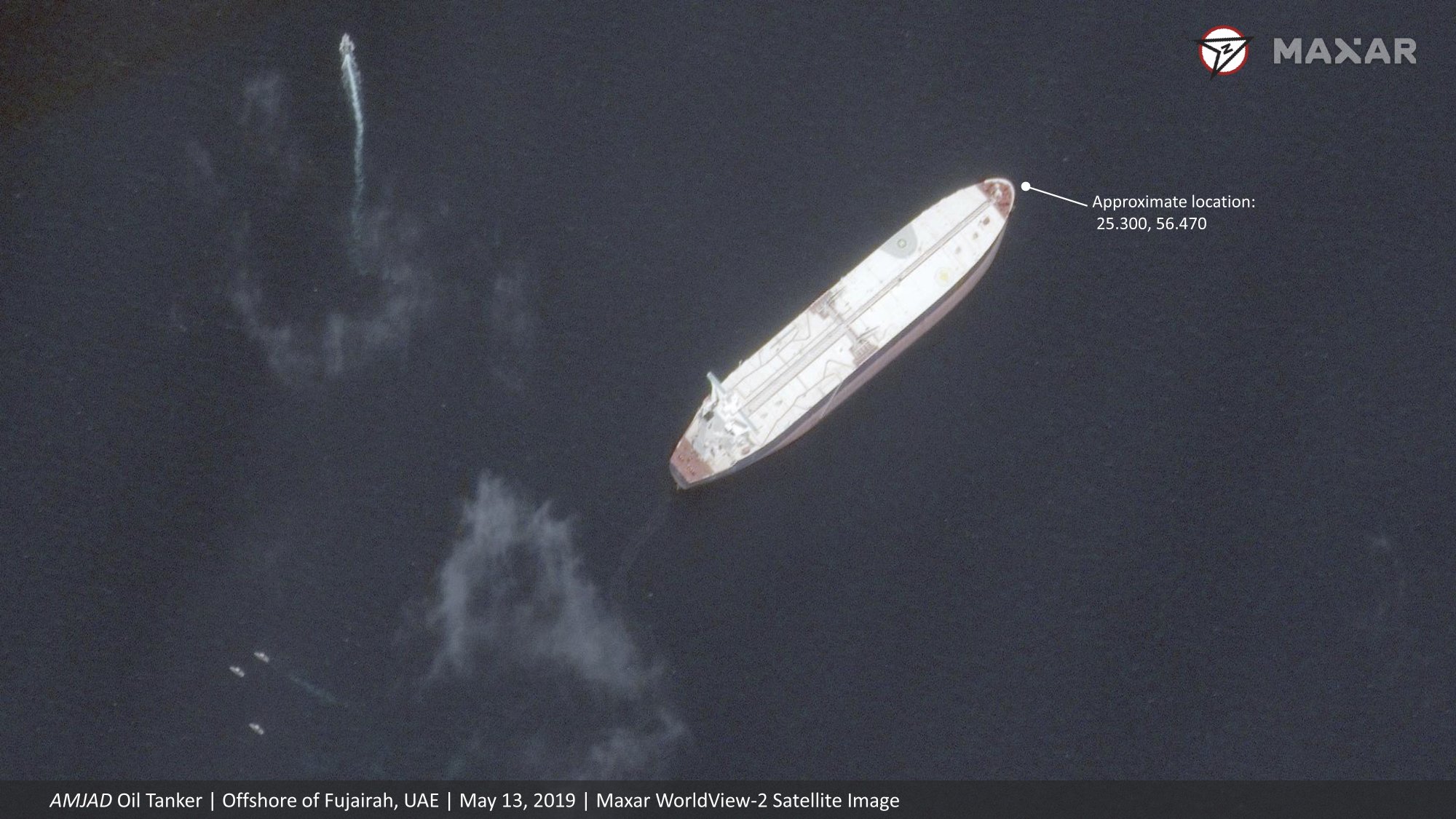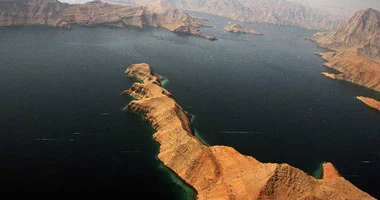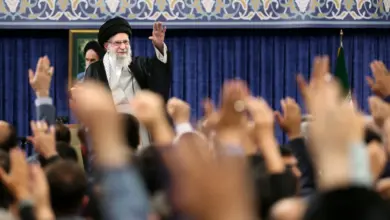
DUBAI, United Arab Emirates (AP) — Four oil tankers anchored in the Mideast were damaged by what Gulf officials described as sabotage, though satellite images obtained by The Associated Press on Tuesday showed no major visible damage to the vessels.
Details of the alleged sabotage to two Saudi, one Norwegian and one Emirati oil tanker on Sunday remained unclear, and Gulf officials have declined to say who they suspected was responsible. But it demonstrated the raised risks for shippers in a region vital to global energy supplies as tensions are increasing between the U.S. and Iran over its unraveling nuclear deal with world powers.
The U.S. has warned sailors of the potential for attacks on commercial sea traffic, and regional allies of the United Arab Emirates condemned the alleged sabotage as the tankers were off the coast of the UAE port city of Fujairah.
A U.S. official in Washington, without offering any evidence, told the AP that an American military team’s initial assessment indicated Iran or Iranian allies used explosives to blow holes in the ships. The official, who was not authorized to discuss the investigation, agreed to reveal the findings only if not quoted by name. The U.S. Navy’s 5th Fleet, which patrols the Mideast and operates from a base in Fujairah, has repeatedly declined to comment.
The U.S. already had warned ships that “Iran or its proxies” could be targeting maritime traffic in the region. America is deploying an aircraft carrier, USS Abraham Lincoln, and B-52 bombers to the Persian Gulf to counter alleged, still-unspecified threats from Tehran.
On Tuesday, Spain temporarily pulled one of its frigates that’s part of a U.S.-led combat fleet from near the Persian Gulf because of mounting U.S.-Iran tensions. The Ministry of Defense said the Méndez Núñez, with 215 sailors on board, will not cross the Strait of Hormuz into the Gulf together with the USS Abraham Lincoln. The Spanish frigate was the only non-U.S. vessel in the fleet.
Citing heightened tensions in the region, the United Nations called on “all concerned parties to exercise restraint for the sake of regional peace, including by ensuring maritime security” and freedom of navigation, U.N. deputy spokesman Farhan Haq said.
The scale of the alleged sabotage also remained unclear. A statement from Saudi Energy Minister Khalid al-Falih said two of the kingdom’s oil tankers, including one due to later carry crude to the U.S., sustained “significant damage.” However, a report from Sky News Arabia, a satellite channel owned by an Abu Dhabi ruling family member, showed the allegedly targeted Saudi tanker Al Marzoqah afloat without any apparent damage.
The oil tankers were visible in satellite images provided Tuesday to the AP by Colorado-based Maxar Technologies. A boom surrounded the Emirati oil tanker A. Michel, indicating the possibility of an oil leak. The other three showed no visible major damage from above.
The MT Andrea Victory, the fourth allegedly targeted ship, sustained a hole in its hull just above its waterline from “an unknown object,” its owner Thome Ship Management said in a statement. Images on Monday of the Norwegian-flagged Andrea Victory, which the company said was “not in any danger of sinking,” showed damage similar to what the firm described.
The U.S. official said each ship sustained a 5- to 10-foot (1.5- to 3-meter) hole in it, near or just below the water line, suspected to have been caused by explosive charges. Emirati officials had requested a team of U.S. military investigators aid them in their probe.
Authorities in Fujairah, also a UAE emirate, also declined to speak to the AP. Emirati officials stopped AP journalists from traveling by boat to see the ships.
The incident raised questions about maritime security in the UAE, home to Dubai’s Jebel Ali port, the largest man-made deep-water harbor in the world that is also the U.S. Navy’s busiest port of call outside of America. From the coast, AP journalists saw an Emirati coast guard vessel patrolling near the area of one of the Saudi ships in Fujairah, some 130 miles (210 kilometers) northeast of Dubai on the Gulf of Oman.
Fujairah also is about 140 kilometers (85 miles) south of the Strait of Hormuz, the narrow mouth of the Persian Gulf through which a third of all oil at sea is traded.
Al-Falih, the Saudi energy minister, said the attacks on the two Saudi tankers happened at 6 a.m. Sunday. He said “the attack didn’t lead to any casualties or oil spill,” though he acknowledged it affected “the security of oil supplies to consumers all over the world.”
The U.S. Energy Department later said it was “monitoring the oil markets, and is confident they remain well-supplied.”
Shortly after the Saudi announcement, Iran’s Foreign Ministry called for further clarification about what exactly happened with the vessels. The ministry’s spokesman, Abbas Mousavi, was quoted by the official IRNA news agency as warning against any “conspiracy orchestrated by ill-wishers” and “adventurism by foreigners” to undermine the maritime region’s stability and security. Both the UAE and Saudi Arabia are staunch opponents of Iran’s government.
Asked at the White House about the incident, President Donald Trump responded: “It’s going to be a bad problem for Iran if something happens.”
Tensions have risen since Trump withdrew America from the 2015 nuclear deal between Iran and world powers, and restored U.S. sanctions that have pushed Iran’s economy into crisis. Last week, Iran warned it would begin enriching uranium at higher levels in 60 days if world powers failed to negotiate new terms for the deal.
European Union officials met Monday in Brussels to thrash out ways to keep the Iran nuclear deal afloat. U.S. Secretary of State Mike Pompeo had traveled there for talks.
“We’re not going to miscalculate. Our aim is not war,” Pompeo told CNBC in an interview. “Our aim is a change in the behavior of the Iranian leadership.”
The U.S. Maritime Administration, a division of the U.S. Transportation Department, warned Thursday that “Iran and/or its regional proxies” could target commercial sea traffic.
The agency issued a new warning Sunday to sailors about the alleged sabotage and urged shippers to exercise caution in the area for the next week.
It remained unclear if the previous warning from the U.S. Maritime Administration is the same perceived threat that prompted the White House on May 4 to order the USS Abraham Lincoln group and the B-52 bombers to the region.
___
Associated Press writers Aya Batrawy in Dubai; Bassem Mroue in Beirut; Amir Vahdat in Tehran, Iran; Malak Harb in Fujairah, United Arab Emirates; and Lolita C. Baldor in Washington contributed to this report.
By JON GAMBRELL
Photo: This satellite image provided by Maxar Technologies shows the Saudi-flagged oil tanker Amjad off the coast of Fujairah, United Arab Emirates, Monday, May 13, 2019. As many as four oil tankers anchored in the Mideast were damaged in what Gulf officials described Monday as a “sabotage” attack off the coast of the United Arab Emirates. (Satellite image ©2019 Maxar Technologies via AP)




